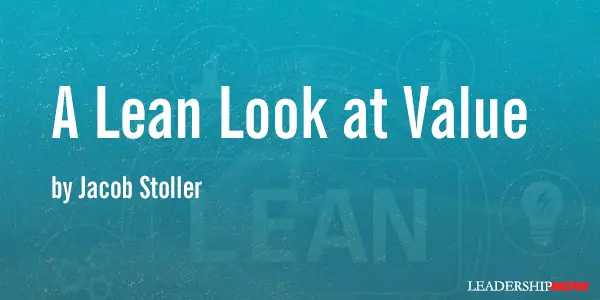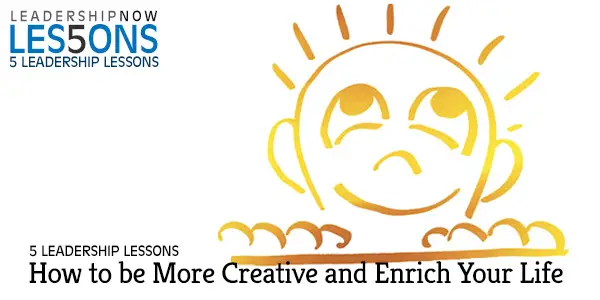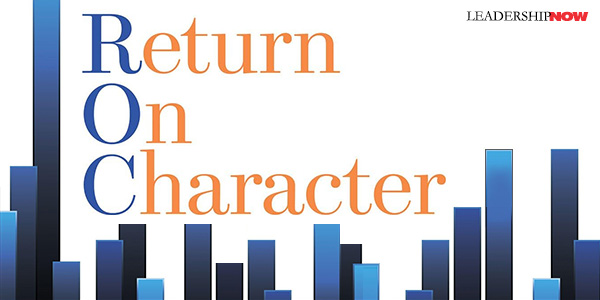 Leading Blog | Posts by Month |
 Leading Blog | Posts by Month |
05.31.15

LeadershipNow 140: May 2015 Compilation
See more on
Posted by Michael McKinney at 04:12 PM
05.18.15

A Lean Look at Value
“Price is what you pay. Value is what you get,” said Warren Buffett, adeptly observing that value is more than just a notion of what something is worth. Customer value that is based on substance, as opposed to perceptions, is widely pursued by organizations that aspire to greatness and is also a fundamental building block of the Lean management system. One of Lean’s great triumphs is that it breaks value down into a set of metrics that can be actively pursued. Leaders who aspire to excellence can gain much from studying this approach. Separating value from waste Toyota, who pioneered Lean methods in the wake of World War II, learned how to maximize value under dire circumstances. Desperate to make the most of scarce resources, they began a relentless campaign to eradicate any expenses or activities that didn’t contribute directly to the value that customers would willingly pay for. In other words, maximizing value – Buffett’s proverbial “what you get” - was a process of elimination. For example, an assembler installing a mirror on a vehicle was at that moment adding value. Walking across the plant to retrieve a screwdriver while the vehicle sat idle, however, was considered non-value or waste. If there were more workers than necessary assembling the car, or more parts than needed in inventory, these were considered wastes that added unnecessary cost to the vehicle. The key here is that the workpiece is treated as a proxy for the customer. It’s almost as if extra walking was keeping the customer waiting, or extraneous activity was wasting the customer’s money. This applies in any industry, whether the workpiece is a manufactured product, a meal in preparation, or an insurance claim under review. In healthcare, the workpiece and the customer are the same, making non-value activity waiting particularly visible and objectionable. Where’s the customer? In Lean organizations, all efforts are focused on the customer experience. To support this, Lean organizations drive improvement using metrics that pertain directly to customer value, such as defect rates, on-time delivery, lead times, and cost indicators such as inventory turns. It also prioritizes roles according to customer value – the closer you are to the customer, the more important the work is. In a factory, the shop floor workers who produce the goods are the most important. In a hospital, it’s the hands-on care workers. In an insurance company, it’s the representatives that are on the phone handling customer claims. This approach has profound implications for employees who don’t make products or interact with customers. By the Lean definition, non-production activity, including IT, engineering, HR, accounting, and yes, senior management, can only provide value indirectly through their support of production. This calls for some major role shifts. HR, instead of sponsoring leadership courses, might spend more time in the workplace helping employees develop problem-solving skills. Accounting, instead of trying to explain variances for the past quarter, might spend their time developing real-time reports to help production supervisors make better buying decisions. And senior managers might step out of the executive suite and find out what more they can do to support their value-creating workers. When assessing whether an activity has value, everything stems from one question: “Why would our customers pay for this?” If the answer is “I don’t know,” maybe it’s time to eliminate it.  
Posted by Michael McKinney at 12:11 PM
05.15.15

5 Leadership Lessons: How to be More Creative and Enrich Your Life
“Curiosity has been the most valuable quality, the most important resource, the central motivation of my life,” writes Hollywood producer Brian Grazer in A Curious Mind. Early in life, Grazer began having what he calls “curiosity conversations.” He began tracking down people he was curious about and asking them if he could sit down with them and talk. He particularly looked for people outside of the entertainment business. The goal was to learn something. He says, “I want to understand what makes people tick; I want to see if I can connect a person’s attitude and personality with their work, with their challenges and accomplishments.” Grazer is a storyteller by trade and it comes through in the stories he tells of the people he has met through his curiosity conversations. Conversations like these get you out of your head and better connected to reality. They provide great insights into yourself and others. It would be a worthwhile goal for anyone to create similar conversations in their own life. And Grazer persuasively argues that you should. (Give one to a graduate. They’ll get it. I put my son on to the project.) Here are five leadership lessons from A Curious Mind. I particularly like the first point as it provides a starting point—a practical behavior—to develop the thinking and the creativity that drives innovation.
“When curiosity really captures you, it fits the pieces of the world together. You may have to learn about the parts, but when you’re done, you have a picture of something you never understood before.” Grazer encourages us to keep asking questions until something interesting happens! And it can start with anyone you come into contact with. Everyone has a story to tell—go and be surprised. 
Posted by Michael McKinney at 07:20 PM
05.08.15

5 Secrets to Learning Better
WITH exam season upon us in the northern hemisphere, experimental psychologist Tom Stafford has offered some lessons for learning better. He and his colleague Mike Dewar, studied how people learn to play an online game. “Computer games provide a great way to study learning: they are something people spend many hours practicing, and they automatically record every action people take as they practice. Players even finish the game with a score that tells them how good they are.” Here is what they found:
Posted by Michael McKinney at 12:06 AM
05.06.15

quickpoint: Generosity Creates Loyalty “There are few things in the world that will change someone’s opinion of you as quickly as generosity” says Jon Acuff in Do Over. “There are few things in the world that will change someone’s opinion of you as quickly as generosity” says Jon Acuff in Do Over.
You will go to bat for people who have shown you generosity. Your employees will work harder. Your clients will return more often. When you are down, people will look for opportunities to pick you up.
Posted by Michael McKinney at 11:19 PM
05.05.15

Return on Character
WE LIVE in an age where wisdom is only wisdom if it is supported by numbers. There are two obvious problems with this. First, we miss a lot because we are looking for immediate return. And so it puts our focus on the wrong things. And secondly, as a result, we tend to assign value to things in terms of numbers. It is assumed that if it gives us the best numbers, it must be the best choice or behavior. Nevertheless, it is satisfying when the numbers do add up. In Return on Character, Fred Kiel has put numbers to the notion that good leadership aimed at promoting the common good, not just individual, winner-take-all acquisition can be good business. In a seven-year study of 121 CEOs, they found that highly principled CEOs—Virtuoso CEOs—achieved nearly five times the return on assets that leaders whose character scores were the lowest—Self-Focused CEOs—in the study. Also encouraging is the fact that people demonstrate character through habitual behaviors and therefore, anyone can learn habits of good character an unlearn habits of poor character. Character is defined in this study as “an individual’s unique combination of internalized beliefs and moral habits that motivate and shape how that individual relates to others.” Our character is what we believe. Despite what we say. Our leadership is what we do for (or to) others as a result of what we believe. To assess character traits Kiel defined four keystone character traits that supported that definition: integrity (telling the truth, acting consistently), responsibility (admitting mistakes, concern for common good), forgiveness (letting go of mistakes of others and ourselves, focusing on what’s right) and compassion (empathizing with and empowering others, caring for others, committed to others’ development). Not surprisingly, self-awareness is a key issue in character development. The Virtuoso leaders rated themselves quite accurately. However, the Self-Focused leaders rated themselves as high as the Virtuoso leaders. Clearly, we have issues seeing ourselves as we are. Perhaps the most important fact revealed by these interviews was whether the leaders knew their life story. Could they provide a coherent narrative about their past, touching on a number of major events, both positive and negative, and including a reasonable description of the effect those events had on their personal development? Virtuoso leaders also had the disciplined decision-making skills that resulted in clearer organizational vision, more focused strategies, a higher-performing executive team, and a stronger culture of accountability. The good news is we can all improve our character—even Virtuoso leaders. Kiel outlines six steps in the personal change process. Step one is probably the most difficult and the key to the whole process. Step 1: Acknowledge Invitations to Change. “Being confronted with an undeniable truth about the way others perceive our behavior and character is a gift.”And that usually doesn’t come in the form we would want it. (If there is such a way!) “No matter what their source, all invitations to change share one thing in common: they make you aware that your current understanding of the world is inadequate, that you have encountered the limits of your level of personal integration. Your existing worldview, your level of mental complexity, or your ability to act in a way that reflects your core values and principles is no longer working, and you have to find a new way forward.” Step 2: Discover What You Want to Change. Understanding exactly what habit you need to change is not always apparent. It requires some self-examination and, quite possibly, some outside help for some additional feedback. Step 3: Find the Fuel for Change. The resolve to make changes is made easier if you connect it to a visionary goal. “I want to be thought of as…” What result do you desire? Step 4: Identify the Keystone Change. What change will contribute the most to your character development? Often a single new habit will bring about other positive character adjustments. Step 5: Disarm Your Security System. Any change will make you uncomfortable. You have to be okay with that. Disarming your brain’s instinctive resistance to change “requires that you face the assumptions that rigger your unwanted responses and behaviors and the true outcomes they produce for you.” Create an action plan. “I will do this when…” This helps you to avoid your automatic responses you are trying to change.
It is not easy to become a Virtuoso leader in a world looking for loopholes. But Return on Character demonstrates that the payoff is there. 
Posted by Michael McKinney at 01:00 PM
05.01.15

First Look: Leadership Books for May 2015Here's a look at some of the best leadership books to be released in May.




For bulk orders call 1-800-423-8273  Build your leadership library with these specials on over 100 titles. All titles are at least 40% off the list price and are available only in limited quantities. “The things I want to know are in books; my best friend is the man who'll get me a book I ain't read.” — Abraham Lincoln
Posted by Michael McKinney at 08:28 AM
|
BUILD YOUR KNOWLEDGE


How to Do Your Start-Up Right STRAIGHT TALK FOR START-UPS 
Grow Your Leadership Skills NEW AND UPCOMING LEADERSHIP BOOKS 
Leadership Minute BITE-SIZE CONCEPTS YOU CAN CHEW ON 
Classic Leadership Books BOOKS TO READ BEFORE YOU LEAD |
|